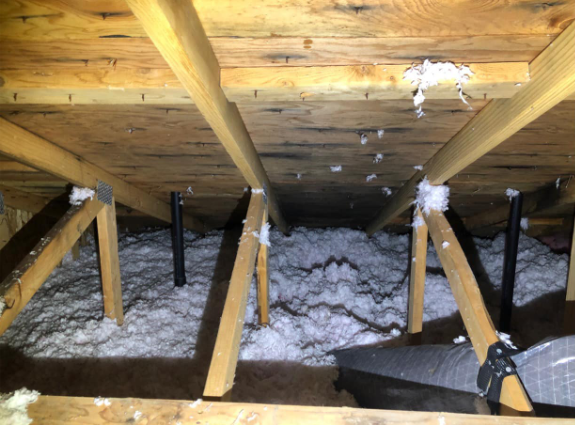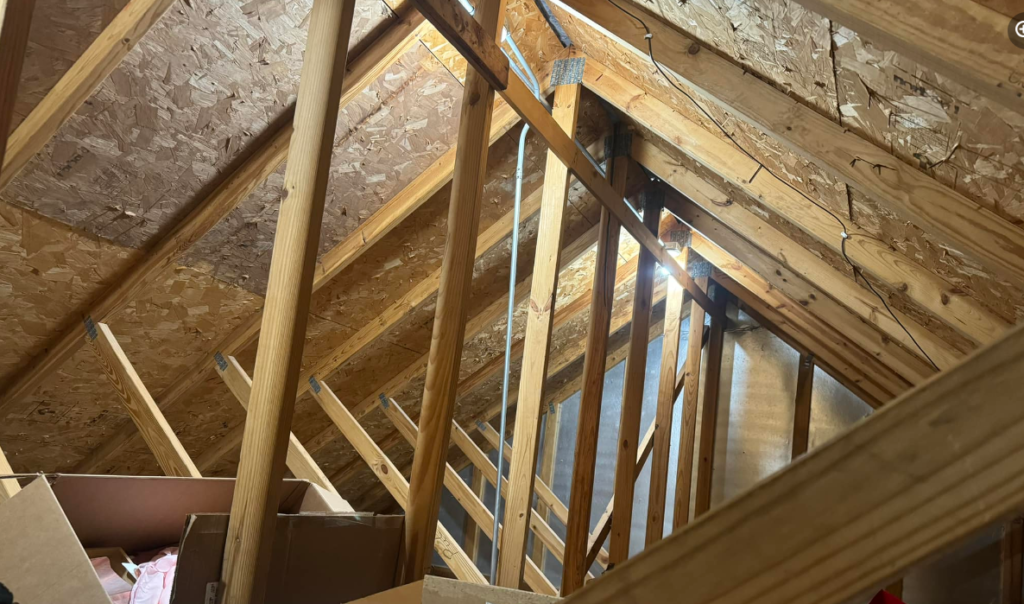Roof Joists Vs. Beams – What Is The Difference ?
 In construction and architecture of roofing, the terms ‘joists’ and ‘beams’ often surface, each with its own distinct role and characteristics. Misconceptions and confusion can arise due to their similar functions, yet understanding the nuances between these two structural components is crucial for anyone involved in the building process.
In construction and architecture of roofing, the terms ‘joists’ and ‘beams’ often surface, each with its own distinct role and characteristics. Misconceptions and confusion can arise due to their similar functions, yet understanding the nuances between these two structural components is crucial for anyone involved in the building process.
This discussion will explore the fundamental differences, the various types and the cost implications of joists and beams, as well as debunking common misconceptions surrounding these essential elements.
As you immerse yourself in this enlightening discourse, you will gain a greater appreciation for the intricate world of construction and architecture.
Key Takeaways
- Beams provide direct support to a structure, while joists evenly distribute the load across the beams.
- Beams are larger and thicker, typically made of 2×10 or 2×12 framing lumber, while joists are smaller and thinner, usually 2×6 or 2×8 framing lumber.
- Beams span the length of the building and provide direct structural support, while joists are closely spaced and used for floor or roof support.
- The choice between joists and beams depends on the specific needs of the construction project, with factors such as size, material, labor, and maintenance affecting the cost.
Understanding Joists And Beams
 To attain a comprehensive understanding of joists and beams, it is essential to delve into their distinctive roles, dimensions, and contributions to a building’s structural integrity. When considering joists vs. beams, one must recognize that beams provide direct support to a structure while joists evenly distribute the load across the beams, providing indirect support.
To attain a comprehensive understanding of joists and beams, it is essential to delve into their distinctive roles, dimensions, and contributions to a building’s structural integrity. When considering joists vs. beams, one must recognize that beams provide direct support to a structure while joists evenly distribute the load across the beams, providing indirect support.
In understanding joists and beams, it is notable that beams are larger and thicker, often spanning the entire home, while joists are smaller, appearing in greater numbers, and usually connecting to the edge of the structure. This difference between beams and joists, in function and size, is crucial in the architectural design of a building for its stability and balance.
Moreover, the materials used differ between a joist and a beam; beams are typically made of 2-inch by 10-inch or 2-inch by 12-inch framing lumber, while joists are usually made of 2-inch by 6-inch or 2-inch by 8-inch framing lumber. Joists and beams work in tandem to support the structure, with beams being the primary load-bearers, distributing weight to foundational supports, while joists provide support to the subfloor and help distribute the load.
If your roof’s structure has issues or you’re looking to get a new one installed, the best roof repair contractors you need can be found in Arkansas. At Luck Roofing, we deliver unparalleled roofing services to Fort Smith and other surrounding areas. Please, don’t hesitate to reach out to us at (479) 397-2228 for expert advice. Your project merits the high standard and dependability we offer. When we inspect your roof before any works we also inspect the beams ,joists and rafters to determine the best course of action for the best outcomes and sometimes beams or braces are used to stabilize the roof structure before any roof repairs are performed.
Basic Differences: Joists Vs. Beams
When analyzing the basic differences between joists and beams, it is crucial to recognize their unique roles, dimensions, and the specific ways they contribute to a structure’s stability. These differences are key to understanding the structural integrity of buildings.
The ‘Basic Differences: Joists Vs. Beams’ can be highlighted as follows:
- Beams provide direct structural support, bearing the weight of the building, whereas joists function to evenly distribute the load across the beams.
- In terms of size, beams are larger and thicker, while joists, being more numerous, are smaller and connect to the structure’s edge.
- Beams have the capacity to span the entire length of a building, while joists butt up against the beams and join to the edge of the structure.
- The term ‘beams’ may also refer to vertical support posts in a pier and beam foundation, whereas joists, distinct in function and appearance, do not share this feature.
- Beams are typically wider, while joists are thinner, reflecting their respective roles in supporting and distributing loads within a structure.
- Ceiling Joists are essentially the reverse of floor joists, ceiling joists bear the load of the roof. Running parallel to the purlins, they are positioned lower in the roof structure. They are connected to the upper part of the wall plates.
Appearance Of Joists And Beams
Building on the fundamental differences between joists and beams, it is equally essential to examine their distinct characteristics in terms of appearance.
The differences between joists and beams are visually distinguishable. Beams, as the primary load-bearing elements, are thicker and fewer in number. They are also wider, made of 2-inch by 10-inch or 2-inch by 12-inch framing lumber. Joists, on the other hand, are thinner and more numerous, with a typical spacing of 16-24 inches on center. They are made of 2-inch by 6-inch or 2-inch by 8-inch framing lumber.
Furthermore, beams can be made from various materials including lumber, LVL, or steel, each lending a distinct appearance. Joists, conversely, are almost exclusively made of lumber. This variety in materials for beams and joists impacts their aesthetic and functional roles in building structures.
| Characteristics | Joists | Beams |
|---|---|---|
| Thickness | Thin | Thick |
| Number | Numerous | Fewer |
| Material | Mostly lumber | Lumber, LVL, or steel |
| Length | Shorter | Longer |
| Spacing | Closer together (16-24 inches on center) | Further apart (several feet on center) |
Functional Differences: Joists Vs. Beams
 Beams and joists play distinct roles in the structural integrity and load distribution within a building. Understanding the functional differences between joists vs. beams is crucial to ensuring these components adequately support the weight of the structure while maintaining design efficiency.
Beams and joists play distinct roles in the structural integrity and load distribution within a building. Understanding the functional differences between joists vs. beams is crucial to ensuring these components adequately support the weight of the structure while maintaining design efficiency.
Beams are primary load-bearing elements that span the length of the building, providing direct structural support to the home and the joists. They can span the entire home and are often thicker and wider, usually made of 2×10 or 2×12 framing lumber
On the other hand, joists are smaller and closely spaced, primarily used for roof support. They are thinner, typically 2×6 or 2×8 framing lumber, and connect to the edge of the structure. Joists evenly distribute the load across the beams, supporting the subfloor and passing the load to the beams and weight-bearing walls or supports.
These key differences highlight the complementary roles of beams and joists in ensuring the structural integrity of a building.
Types Of Joists And Beams
Diving deeper into the subject, it becomes evident that both joists and beams come in various types, each with unique characteristics and purposes in building construction. Joists, commonly used in floor and roof structures, come in many forms such as the open web steel joist (OWSJ) or the engineered wood joist (EWJ). Beams, on the other hand, can be distinguished by their location and function, such as the ridge beam in roofs or girders that support floor joists.
| Types of Joists | Types of Beams |
|---|---|
| Open Web Steel Joist (OWSJ) | Ridge Beam |
| Engineered Wood Joist (EWJ) | Girder |
| Lightweight Steel Joist | Laminated Veneer Lumber Beam |
| I-Joist | Glulam Beam |
| Solid Sawn Joist | Steel I-Beam |
In the joists vs. beams debate, it is crucial to consider the specific needs of your construction project. These structural elements have distinct roles in supporting and stabilizing buildings. A floor joist, for instance, may not bear as much weight as a roof beam, but it plays a crucial part in evenly distributing weight to prevent structural damage.
Comparing Costs: Joists Vs. Beams
When comparing the cost of joists and beams, several factors come into play. These include the size, material, and function of these structural components. In residential construction, these elements are vital for the structural integrity of the home, and their cost can significantly impact the overall budget.
Engineered wood is a common material used for both joists and beams due to its strength and flexibility. It is generally more affordable than steel beams, which offer high durability but at a higher cost.
Labor costs also play a significant role in the overall cost. Installation of beams is generally more labor-intensive due to their size and weight, thus leading to higher labor costs.
The size and number of joists and beams required can also affect the cost. More joists are typically needed in a structure, potentially raising the cost.
The function of the component in the structure can also impact the cost. Beams, being primary load-bearing elements, are typically more costly than joists.
Maintenance costs should also be considered. Steel beams, for example, may require less maintenance than wood, potentially saving money in the long run.
Therefore, when comparing costs: joists vs. beams, one must consider all these factors for an accurate evaluation.
Common Misconceptions: Joists Vs. Beams
Navigating the world of construction terminology can often lead to misunderstandings, particularly when it comes to differentiating between joists and beams. A common misconception is that these two structural elements are interchangeable. However, this couldn’t be farther from the truth.
The primary function of beams is to serve as load-bearing elements, providing direct structural support to the building. They are typically larger, thicker, and fewer in number compared to joists. Beams can span the entire length of a home and can also refer to vertical support posts in a pier and beam foundation.
On the other hand, floor joists, smaller and more numerous than beams, butt up against the beam and connect to the edge of the structure. They distribute the load evenly across the beams, helping to maintain the stability of the flooring or roofing systems above them.
Final Thoughts
In conclusion, the differences between joists and beams are fundamental to construction and architecture, with each playing a distinct role in supporting the structural integrity of buildings.
Understanding these differences, in terms of appearance, function, types, cost, and common misconceptions, is crucial for those involved in construction projects.
Engaging professional roofing services ensures that these components are installed correctly, adhering to safety standards and building regulations, thereby securing the longevity and sustainability of the structure.
Michael Overzat
Michael Overzat resides in Fort Smith, Arkansas with his wife and three kids. He enjoys to hike, skateboard, write, and get involved in charity organizations. He was originally born in Maryland. He has worked within the roofing industry for 5 years and is very active within the industry by attending conferences, masterminds, etc. His vision is to create a multi-state organization that has a customer centric model. He's worked for some of the biggest names in the industry and hopes to create a more people focused model for the roof replacement process.
